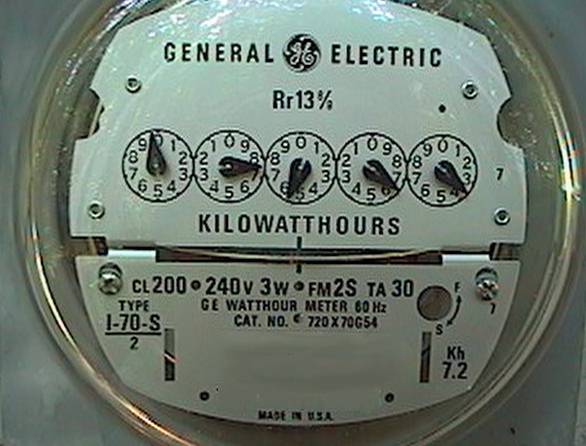The electric meter is definitely more difficult to read than the water
meter. First, there are more dials, and notice every other dial is
reversed like a backwards clock face. The reason for the
reversals is the mechanical convenience of the gears that turn the dials
- it's a more reliable design with less parts to fail.
When reading multiple dials, the primary rule is how to handle to a dial
that points almost directly to a number. Take the leftmost dial, you
can see it doesn't quite point to 0, so its value is still 9. But
imagine if it were closer to the 0, how could you tell if it was still
9 or had moved to the next number, 0?
When a dial is very close to a number, look at the next dial down.
In this case, the
one just to the right. Is it somewhere between 0 and 2, or between 8
and 0? For that first dial to point directly to a number, the next
dial over must be near 0, either just before or just after 0. THAT
second dial's position settles the question about the first dial.
You may need to think about
this concept and re-read this paragraph. It is very necessary to
correctly read your meter.

Now let's read this meter. The first dial is '9', although it's close
to '0', the next dial down is between 7 and 8 so this first digit will
become '0' only later, after that second dial finally passes '0'. The
second digit is '7' (beyond 7, but definitely not 8 yet).
The third digit is '5', the next is '6', then the last is
'3'. The current reading is "97563 Kilowatt/Hours".
Notice the final meter reading
is in Kilowatt Hours (or 1000 watt hours) - still in thousands,
just like the water meter.
Most of the time, the average house has a number of electrical devices
drawing power, such as refrigerators and clocks. And you can see
the power usage of them with the spinner - located immediately under
words "KILOWATT HOURS" there is a slot across the meter, and the edge
of a thin, flat disc is visible. It is marked numerically 0 to 100
by 10s and with 100 small tick marks. On this meter, each full
revolution of the disc is 7.2 watts.
( Why exactly 7.2? )
With the disc is making a full revolution
every 30 seconds, or 120 revs per hour, then 120 X 7.2 = 864
Watts at that moment. If that pace continues for an hour,
then 864 watt/hours is consumed, which is 0.864 KWH.
Notice if the disc makes one revolution for 7.2 watts, then each small
mark around the disc represents 0.072 watts or 72 milliwatts.
This extreme sensitivity allows electricians to check for faults
and to verify if ANYTHING is drawing power at that time.
All homes have breaker or fuse boxes inside that can be used to turn
off the power to the home. Some apartments and condos have external
power switches near the power meters. If your power is off and you
want the power turned on, you must either turn off
your main breaker for the entire house or be at home when the service
person arrives.
For when you have the power restored, the person
installing the meter will immediately notice the spinner moving.
If you are not home, they will have no way of knowing whether that
current is running only
your refrigerator or perhaps a stovetop burner! For safety they
cannot leave your power connected. If there is an outside switch,
they can turn that switch off, and leave a note on your door, and
you'll have to turn the switch on. But for a house, if you're not
home, you'll have to make another appointment and be home the
next time, or leave your main breakers turned off.
No, you don't have to turn your power completely off just
to get the service transferred to your name - this is only
in the case where there was NO power at the time, and it needed
to be restored. All utilities prefer to have you just transfer
the account from one person's name to the next and save the
actual visit from a utility worker.
Don't read this! This is painfully detailed information about
how this meter's spinner ended up with such a round number like 7.2
watts per revolution.
On the face of the meter, you can see "Rr 13 8/9", which is the worm
gear ratio from the shaft of the spinner disc to the idler gear.
"Rs" is standard at 100 for most GE meters and that's the ratio from
the idler gear to one revolution of the least significant digit on
the meter. "Rg" is the total gear ratio (Rg = Rr X Rs), so Rg = 13.88
X 100 = 1388. And one revolution of the least significant digit is
10,000 KW (one complete REVOLUTION of the dial, not just one number).
This 10,000 KW is divided down 1388 times driving the spinner disc.
So 10,000 KW divided down 1388 times (10,000 / 1388 = 7.2), or
7.2 watts per revolution of the disc. And with 100 divisions on the
disc, you get a resolution of 72 mw. per division.
Oh, there's also a simpler way to figure this. "Kh" is the watthour
constant, a.k.a., the watts/revolution of the disc. AND, if you look in
the lower right side of the meter face, you'll see "Kh 7.2". Yes,
you could have looked there, but wasn't my explanation above more
fun to follow?
|